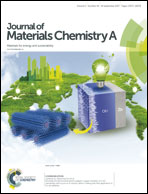BIAN based functional diimine polymer binder for high performance Li ion batteries†
Abstract
A bis-imino-acenaphthenequinone (BIAN)–fluorene copolymer (π conjugated polymer bearing BIAN and fluorene units) binder was designed, synthesised and used for the fabrication of a graphite electrode in lithium-ion batteries. Unlike the PVDF binder, the electrode with the BIAN–fluorene binder exhibited significantly improved electrochemical performance in terms of its rate capability, cycling behaviour and specific capacity. At a rate of 1C, the electrode with the BIAN–fluorene binder exhibited more than 250 mA h g−1 capacity after 100 cycles while the electrode made with the PVDF binder delivered only 165 mA h g−1. The significant improvement of cycling performance is due to the improvement in the adherence of the electrode laminate to the current collector and improved interface. Electrochemical impedance spectroscopy and dynamic electrochemical impedance spectroscopy studies showed the formation of an improved interface with the BIAN–fluorene based binder.



 Please wait while we load your content...
Please wait while we load your content...